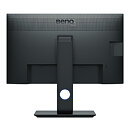Sunday, July 19th 2020

BenQ Launches SW321C 32-inch Professional Monitor
BenQ, a global leader in digital lifestyle devices, continues its legacy of excellence in photo and video editing monitors with the debut of SW321C. The 32" 4K UHD display lets professionals create better work, faster. Expertly calibrated screen uniformity, HDR10 support, and new Paper Color Sync for color accurate print previews make SW321C the best 4K monitor for photo and video editing.
Designed with photographers in mind, SW321C features BenQ's new Paper Color Sync, which enables screen-to-photo color matching for soft proofing images before printing. By matching the image on the display to your paper profile, SW321C allows precise results while easing workflow. The new monitor also incorporates updated Uniformity Technology to ensure edge-to-edge display consistency. Also noteworthy, the innovative panel is specially designed to reduce reflection and glare to absolute minimal levels."BenQ's SW321C Hardware Calibrated display is the new benchmark for color accurate displays for photographers and videographers," says Art Suwansang, acclaimed photographer. "With Paper Color Sync mode to emulate print, along with the new panel featuring Uniformity Version 2 and the innovative matte coating, this display sets the standard of color accurate displays for photographers and videographers."
Established fans of BenQ proprietary AQcolor technology will enjoy industry-standard color performance in this flagship model. SW321C covers 99% Adobe RGB, 95% DCI-P3 / Display P3 and 100% sRGB color spaces. The 10-bit color depth and 16-bit 3D lookup table produce pristine colors with Delta E≤2 accuracy. For added confidence, each SW321C comes with its unique factory color calibration report and certifications from CalMAN and Pantone.
SW321C's GamutDuo function displays the same image, side-by-side, in different color spaces, such as Adobe RGB and sRGB. Black and white mode previews film effects before adjusting pictures. All of these color modes can be instantly switched via BenQ's Hotkey Puck G2 to enhance efficiency.
Generously equipped to support video as well, SW321C natively supports uncompressed 4:4:4 or 4:2:2 and 4:2:0 chroma 10-bit video formats as well as HDR10 and HLG capability for vibrant and lifelike video quality.
BenQ knows details matter. SW321C is equipped for success with USB-C connectivity for audio/data/video and power delivery. The stand is height/tilt adjustable, and the display includes a professional shading hood. There is even a custom-designed roller to preserve the anti-glare/anti-reflective panel.
For more information, visit the product page.
Designed with photographers in mind, SW321C features BenQ's new Paper Color Sync, which enables screen-to-photo color matching for soft proofing images before printing. By matching the image on the display to your paper profile, SW321C allows precise results while easing workflow. The new monitor also incorporates updated Uniformity Technology to ensure edge-to-edge display consistency. Also noteworthy, the innovative panel is specially designed to reduce reflection and glare to absolute minimal levels."BenQ's SW321C Hardware Calibrated display is the new benchmark for color accurate displays for photographers and videographers," says Art Suwansang, acclaimed photographer. "With Paper Color Sync mode to emulate print, along with the new panel featuring Uniformity Version 2 and the innovative matte coating, this display sets the standard of color accurate displays for photographers and videographers."
Established fans of BenQ proprietary AQcolor technology will enjoy industry-standard color performance in this flagship model. SW321C covers 99% Adobe RGB, 95% DCI-P3 / Display P3 and 100% sRGB color spaces. The 10-bit color depth and 16-bit 3D lookup table produce pristine colors with Delta E≤2 accuracy. For added confidence, each SW321C comes with its unique factory color calibration report and certifications from CalMAN and Pantone.
SW321C's GamutDuo function displays the same image, side-by-side, in different color spaces, such as Adobe RGB and sRGB. Black and white mode previews film effects before adjusting pictures. All of these color modes can be instantly switched via BenQ's Hotkey Puck G2 to enhance efficiency.
Generously equipped to support video as well, SW321C natively supports uncompressed 4:4:4 or 4:2:2 and 4:2:0 chroma 10-bit video formats as well as HDR10 and HLG capability for vibrant and lifelike video quality.
BenQ knows details matter. SW321C is equipped for success with USB-C connectivity for audio/data/video and power delivery. The stand is height/tilt adjustable, and the display includes a professional shading hood. There is even a custom-designed roller to preserve the anti-glare/anti-reflective panel.
For more information, visit the product page.





19 Comments on BenQ Launches SW321C 32-inch Professional Monitor
In a 32" Benq SW model you expect to get this kind of severe uniformity issues, up to 3 deltaC 3 inches away from center (row 3, col 4)... and thats just pink-green tints without caring about brightness drop:
Same goes for SW2700PT, SW271, etc.
SW270C managed to improve it with some "uniformity compensation" on some OSD modes which user cannot switch off, destroying contrast in return, so you get a 600:1 contrast at D65 white. Same useless monitor as all the other Benq SW. They sell that SW270C sh*t with a price of 800 euro where Eizo CS2731 has none of these issues and it's just 200 euro more expensive. Also Eizo's ColorNavigator HW calibraction actually works as intended where Benq Palette Master does not.
Save a few bucks and go to NEC or Eizo, or go down to a 27" display in these brands if you cannot afford a 32". Otherwise it's a waste of money and time.
Low cost AdobeRGB monitor = fool's gold
I bought one in 2007 and i dont think in last 10 years i ever read anywhere about any Nec monitor until just now in your post.
-Eizo CS line. 1000:1, HW calibration (LUT1D + matrix + LUT1D)
-Eizo "limited" CG line (CG2420, CG2730). 1500:1, HW calibration (LUT1D+ matrix + LUT1D)
-NEC PA line: 1500:1, HW calibration LUT3D
-Eizo CG line: 1300-1500:1, HW calibration LUT3D
CS or CGs have a slight better color uniformity than PA without enabling uniformity compensation, but NEC PAs have 5 step to choose how much contrast you loose until uniformity is OK for your task. Eizos just on/off selector.
Uniformity compensation (UC) is contrast destructive because you have to lower max output in some channels for some pixels (zones) to make them look equal. The worse base color uniformity is, the more it needs to be corrected so contrast is destroyed/limited in return.
-Typical CS is color uniformity perfect out of the box, brightnes uniformity in corners up to -15%. Once UC enabled 1000:1 goes to 850:1 typical.
-Typical PA is not color uniformity perfect out of the box but good, brightnes uniformity in corners up to -15%. Once UC near max level enabled 1500:1 goes to 1000:1 typical.
-Typical CG is color uniformity perfect out of the box, brightnes uniformity in corners up to -10%. Once UC near max level enabled 1300-1500:1 goes to 1000:1 typical.
Garbage like SW321 are 1000:1 LUT3D but with faulty software (Palette Master Elements) and one of the following issues
-disgusting color uniformity with pink or green tint in some partes of the screen, even near the center. You can spot them easily even in Windows Explorer or Internet browsing in a "white" web like this.
-destroyed contrast due to uniformity compensation, 600:1 like SW270C in prad.de's report.
Useless displays...
www.necdisplay.com/
Most if not all of the EIZO Professional ones are 16:10.
Only 16:10 that are sold right now are 24". All the other models are 16:9 or DCI-4k. Last model 16:10 was NEC PA302W (2014 maybe?) and almost no one bought it due to price gap against PA272WAsus is even worse. Benq HW cal solutions lacked spectral corrections for i1displaypro... Asus did not use them, at least a few versions ago.
Also when you enabled Asus uniformity compensation it only fixed brightness uniformity but color uniformity went worse (green tints or pink across screen). We can see it in pard.de's review & others.
All the fuss with Benq & Asus are caused by paid reviews and "ambassador" program whcih contaminates blogs & social networks with a lot of mumbo jumbo but zero objective test like the ones prad.de or Photography Life do. When actual test are done... you saw it above: uniformity issues everywhere or destroyed contrast at 600:1 for a "videographer monitor".
The only one who managed to get a decent uniformity was Dell with UP2720Q (27" UHD 1700-2000 euro)... but it costs more than Eizo counterpart CS2740. I like more Eizo's Color Navigator than Dell's DUCCS software, because visual whitepoint match when there are metameric failures. Anyway, impressive color unifomity for a Dell:
I've used some of their widegamut models and none of them were vene close to that... hence price gap between other dells and this one.
The price they pay to panel manufacturer fixes the QC they get... which is none for final objective price of SW line and AUOptronics as panel source.
Quantum dot displays should not have the colour tint issue, do you know of any professional grade displays that use those?
www.xtof.info/blog/?p=887
There are other owners reports with DisplayCAL showing the same amount of tints, just google and they appear. SW2700PT is QD for sure, spectral power distribution (DisplayCAL community) shows that, same for PV270.
Other models "supposed to be color critical" using QD are some PA Asus, and show the same severe pink or green tints across screen. For example Asus PA329/Q. You can see QD spectral power distribution signature in displaycal community database and a lot of reviews with the same 3dC when you move from center, the more dense the grid, the more noticeable it is in uniformity reports because user cannot "cheat" with probe placement. Asus UC just improves brightness uniformity (% drop), but tints (deltaC) remain there.
Also Benq mixes several backlight types across SW line (QD, GB-LED, W-LED PFs phosphor) with the same bad uniformity=no QC, although models like SW240 (WLED PFS from DisplayCAL community) with smaller screens should have some chance to get a good one. Mission impossible on the big 27" or 32".
I mean... what you actually pay for with a Coloredge or Spectraview is QC and uniformity. There are other extremely useful features like a working HW calibration software with visual whitepoint matching that are not present in Dells or Benqs or Viewsonics or Asus with HW calibration but most of them could be solved even in a no user friendly way ("just software").
Uniformity issues cannot be corrected. You take display out of the box, plug it, test ist at some whitepoint coordinates with UC enabled or disabled and that's all you can get from that display. It is not going to improve and as it ages it will go worse.
However, QD does not need to be just a backlight type. QD can be implemented like OLED, each dot representing a pixel. That is supposed to match OLED in every aspect, without the downsides. Unfortunately, nobody has figured out how to manufacture that at scale so far.
600:1 contrast at D65 white, 3dC uniformity errors, high range using Benq HW calibration... a bad monitor as all Benq SW have been.
Benq never made a good photo monitor and this time they failed again.
PS: It uses a WLED PFS phosphor backlight, Benq HW calibration software cannot measure it properly (as expected).
Stay away from AdobeRGB widegamuts from benq, asus, etc...